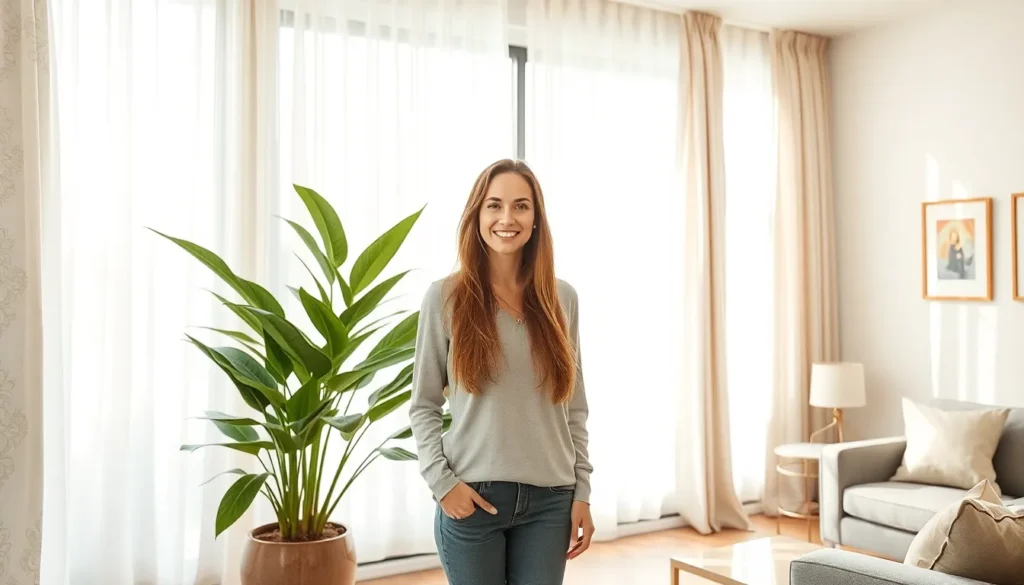Floor-to-ceiling mirrors can dramatically transform a living room’s appearance but sometimes we need creative answers to modify their impact. Whether you’re dealing with outdated mirrored walls from the 80s or simply want to soften their overwhelming presence we’ve got you covered with practical and stylish options.
Transforming your mirrored walls doesn’t have to expensive or require major renovations. From temporary answers like decorative panels and curtains to more permanent options like paint treatments and wall coverings there are countless ways to customize these reflective surfaces to match your personal style.
We’ll explore innovative techniques that can help you create a more balanced and inviting living space while working with your existing mirror installation. These answers range from budget-friendly DIY projects to professional-grade treatments that’ll give your room the perfect finishing touch you’ve been searching for.
Use Elegant Curtains or Drapes to Create a Soft Covering
Curtains provide the most versatile and cost-effective solution for covering ceiling to floor mirrors. This approach transforms harsh reflective surfaces into warm, inviting focal points that enhance your room’s comfort level.
Choose Floor-to-Ceiling Panels for Full Coverage
Floor-to-ceiling panels create dramatic visual impact while completely concealing mirrored walls when needed. We recommend measuring your space precisely to ensure panels extend from ceiling mounting points to floor level without gaps.
Custom panels work exceptionally well for irregularly shaped mirror installations or rooms with unique architectural features. Standard 84-inch or 96-inch ready-made panels suit most residential spaces with 8 to 10-foot ceilings.
Weighted hems prevent panels from billowing and maintain clean lines against your mirror surface. We suggest adding chain weights or fabric weights sewn into the bottom hem for optimal draping.
Double-width panels provide fuller coverage and create luxurious gathered effects when drawn across large mirror expanses. This technique works particularly well for living rooms where you want to control natural light reflection throughout different times of day.
Select Fabrics That Complement Your Living Room Decor
Fabric selection directly impacts how successfully curtains integrate with your existing living room aesthetic. We recommend choosing materials that coordinate with your current color palette while adding desired texture contrast.
Heavyweight fabrics like velvet, linen, or cotton blends provide excellent coverage and reduce mirror visibility even when curtains are closed. These materials also offer superior light control and create cozy atmospheres in modern living spaces.
Sheer or semi-sheer fabrics allow you to maintain some mirror functionality while softening harsh reflections. Voile, chiffon, or lightweight cotton creates gentle filtering effects that preserve natural light flow.
Patterned fabrics can camouflage mirror edges and create visual interest that draws attention away from reflective surfaces. We suggest selecting patterns that complement your furniture upholstery or existing wall art for cohesive design flow.
Neutral tones like cream, taupe, or soft gray provide timeless appeal and work with various decorating styles. Bold colors or rich jewel tones create striking focal points that transform mirrors into design assets rather than obstacles.
Install Ceiling-Mounted Tracks for Easy Access
Ceiling-mounted tracks offer superior functionality and create seamless appearances that maximize your room’s vertical space. We recommend professional installation for heavy curtain systems or complex track configurations.
Motorized tracks provide convenient remote control operation for frequently adjusted mirror coverings. These systems work particularly well in large living rooms where manual operation becomes cumbersome.
Curved tracks accommodate bay windows or angled mirror installations that require custom fitting answers. This hardware allows curtains to follow architectural lines while maintaining smooth operation.
Double track systems enable layering of sheer and opaque panels for maximum flexibility. We suggest installing tracks at least 6 inches apart to prevent fabric interference during opening and closing operations.
Bypass tracks allow individual panel control when covering multiple mirror sections or room zones. This configuration lets you expose exact mirror areas while keeping others covered based on your daily needs and lighting preferences.
Install Sliding Room Dividers for Functional Style
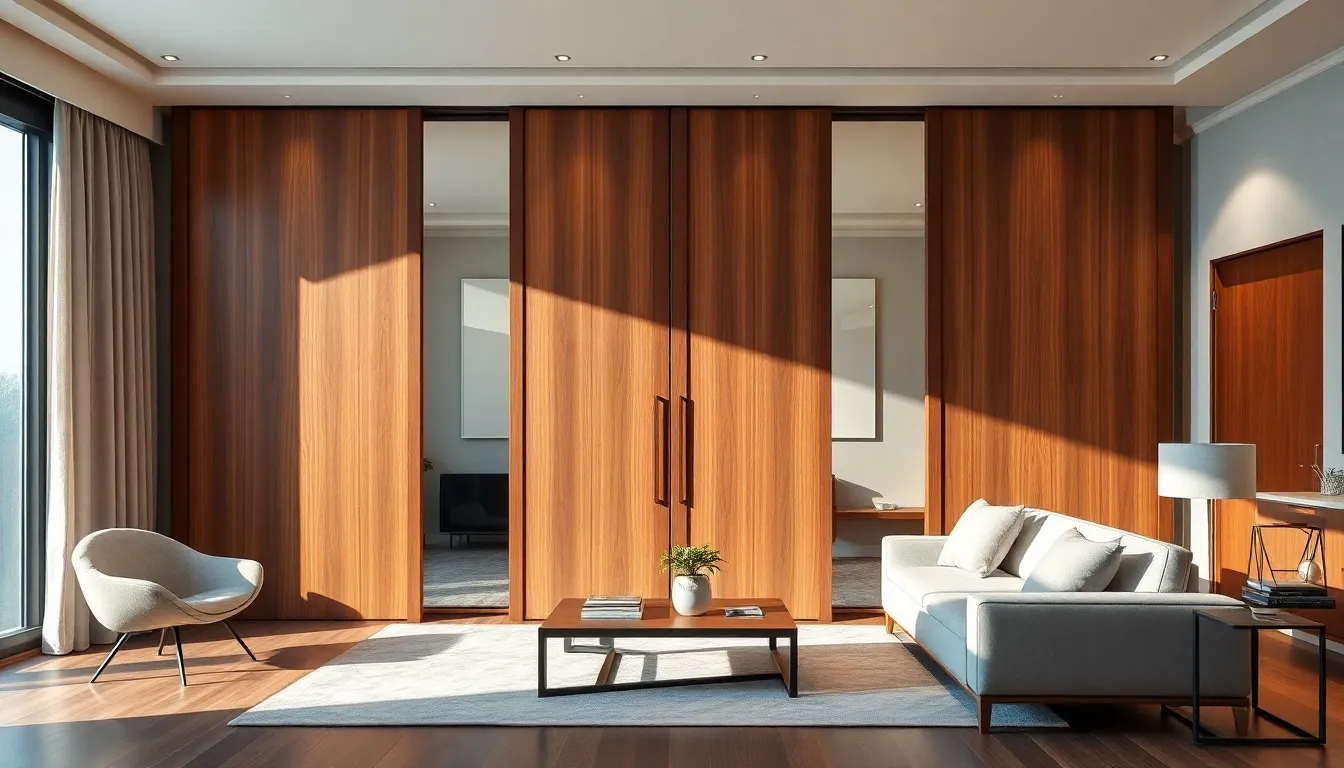
Sliding room dividers offer a perfect blend of aesthetics and practicality when we need to manage large mirror installations. These versatile answers let us control visibility while adding architectural interest to our living spaces.
Opt for Wooden Panel Screens for Warmth
Wooden panel screens bring natural texture and cozy ambiance to spaces dominated by reflective surfaces. We can choose from traditional shaker-style panels or sleek modern designs that complement our existing decor. These screens work exceptionally well when crafted from warm wood tones like walnut or oak, creating visual balance against cool mirror surfaces.
Installation becomes straightforward when we mount ceiling tracks that support smooth sliding mechanisms. The wooden panels can be customized to match our furniture finishes, ensuring seamless integration with bookcases, coffee tables, or entertainment centers already in the room.
Consider Fabric-Covered Dividers for Texture
Fabric-covered dividers introduce softness and sound absorption while concealing mirrors when needed. We can select upholstery materials that echo our sofa cushions or throw pillows, creating cohesive design flow throughout the living area. Linen, velvet, or textured cotton options work particularly well for this application.
These dividers offer superior customization since we can easily change fabric covers seasonally or when redecorating. The padding behind fabric panels also helps reduce sound reflection from mirror surfaces, making our living room feel more intimate and comfortable.
Use Metal Frames for Modern Industrial Look
Metal frames deliver clean lines and contemporary appeal that works beautifully in modern living spaces. We can choose from brushed steel, black iron, or brass finishes that coordinate with our lighting fixtures and hardware throughout the room. These frames often feature frosted glass or mesh panels that partially obscure mirrors while maintaining some transparency.
The industrial aesthetic pairs exceptionally well with leather furniture, concrete elements, or exposed brick walls. Metal sliding systems typically offer the smoothest operation and longest durability, making them ideal for frequently used applications where we regularly adjust mirror coverage throughout the day.
Apply Decorative Window Film for Privacy and Style

Decorative window films offer an innovative solution that transforms your floor-to-ceiling mirrors while maintaining their reflective properties. We can apply these versatile films to create privacy and add sophisticated design elements without permanent alterations.
Select Frosted Film Patterns for Subtle Elegance
Frosted films create an sophisticated aesthetic that allows light to pass through while obscuring direct reflections. We recommend geometric patterns like hexagons or diamonds for modern living rooms, while floral designs work beautifully in traditional spaces. Abstract patterns offer versatility that complements various interior styles without overwhelming the room’s existing decor.
These films provide the perfect balance between maintaining natural light flow and reducing the mirror’s stark reflective impact. Installing frosted patterns creates visual texture that softens the appearance of large mirrored surfaces. The subtle elegance of these designs blends seamlessly with most color schemes and furniture arrangements.
Choose Colored Films to Match Your Color Scheme
Colored decorative films transform plain mirrors into stylish accent pieces that complement your living room’s palette. We suggest selecting translucent hues that echo your existing furniture colors or wall paint for a cohesive look. Warm amber tones create cozy atmospheres, while cool blues and greens provide calming effects.
Tinted films add depth and visual interest without completely blocking the mirror’s functionality. These colored options allow you to customize the mirror’s appearance to match seasonal decor changes or evolving style preferences. The translucent quality maintains some reflective properties while significantly reducing the mirror’s overwhelming presence.
Use Etched Designs for Artistic Appeal
Etched glass films mimic the sophisticated look of professionally engraved glass at a fraction of the cost. We can choose from intricate botanical motifs, Art Deco patterns, or contemporary abstract designs that turn your mirror into a focal point. These films combine functionality with decorative art to create unique visual interest.
The three-dimensional appearance of etched designs adds texture and depth to flat mirror surfaces. Installing these artistic films transforms utilitarian mirrors into conversation pieces that enhance your living room’s overall aesthetic. The easy application and removal process allows for updates and changes as your design preferences evolve.
Hang Large Artwork or Tapestries as Statement Pieces

Transform your ceiling-to-floor mirror into a curated art display by strategically placing large statement pieces that create visual focal points. We’ll show you how to use oversized artwork and textiles to add personality while maintaining the mirror’s functional benefits.
Mount Oversized Canvas Prints for Bold Impact
Canvas prints measuring 48 inches or larger create dramatic focal points that naturally draw attention away from reflective surfaces. Position these bold pieces at eye level alongside your mirror to establish visual balance and add color depth to your living space.
Select prints with vibrant colors or striking patterns such as abstract compositions, industry photography, or contemporary art that complements your existing decor palette. We recommend choosing pieces that measure at least one-third the width of your mirror to achieve proper proportional balance.
Install heavy-duty wall anchors rated for 50+ pounds to securely mount oversized canvas prints without damaging your walls. Space multiple large pieces 18-24 inches apart to create breathing room while maintaining cohesive visual flow throughout your living room.
Display Textile Wall Hangings for Bohemian Flair
Macrame wall hangings bring organic texture and bohemian charm to spaces dominated by reflective surfaces. Choose pieces with natural fibers like cotton rope or jute that measure 36-60 inches in length to create proper scale against floor-to-ceiling mirrors.
Embroidered tapestries add cultural richness and warmth while softening the hard edges of mirrored walls. We suggest selecting pieces with earth tones or jewel colors that echo your living room’s accent colors for seamless integration.
Layer different textile pieces at varying heights to create visual interest and partially obscure mirror sections. Position larger tapestries centrally with smaller macrame pieces flanking the sides to establish balanced composition and bohemian styling.
Create Gallery Walls with Multiple Smaller Pieces
Arrange 12-15 smaller art pieces in clustered formations to create captivating gallery walls that distract from overwhelming mirror presence. Mix photographs, prints, and small paintings in frames ranging from 8×10 to 16×20 inches for optimal visual variety.
Maintain consistent spacing of 2-3 inches between frames to ensure cohesive gallery wall appearance while allowing each piece to stand out individually. We recommend creating paper templates first to plan your arrangement before committing to wall placement.
Combine different frame styles and artwork types such as black and white photography, colorful prints, and textured pieces to add depth and personality. Start with your largest piece as an anchor point, then build outward with complementary smaller works to achieve professional gallery styling.
Build Custom Shelving Units to Conceal and Organize
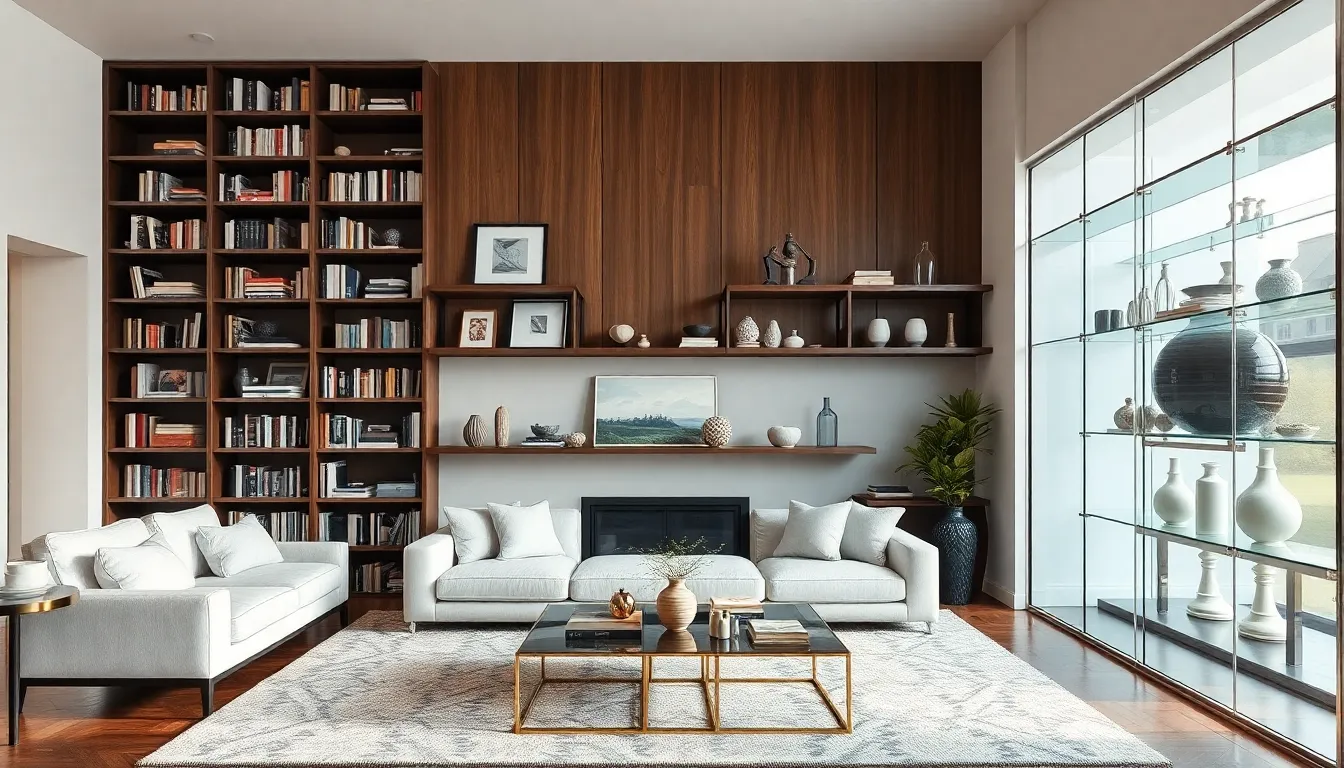
Custom shelving transforms overwhelming mirror walls into functional storage answers while maintaining your living room’s aesthetic appeal. We’ll explore three effective approaches that maximize both concealment and organization potential.
Design Floor-to-Ceiling Bookcases for Storage
Floor-to-ceiling bookcases create complete mirror coverage while providing ample storage space for books, decorative items, and household goods. We recommend measuring your mirror dimensions precisely to ensure proper fit and seamless integration with existing room elements.
Built-in bookcases offer the most polished appearance and can be customized to match your living room’s architectural style. Oak, maple, and walnut wood species provide durability and timeless appeal that complements various design themes. Modular bookcase systems present a budget-friendly alternative that allows for future reconfiguration as your storage needs evolve.
Incorporate adjustable shelving to accommodate items of varying heights, from oversized coffee table books to small collectibles. We suggest adding cabinet doors to lower sections for concealing less attractive storage items while keeping frequently accessed books and decor on open shelves above.
Install Floating Shelves at Strategic Heights
Floating shelves create visual layers that effectively distract from mirror surfaces while providing display opportunities throughout the room. We position shelves at 18-inch intervals to create balanced proportions and accommodate various decorative items.
Strategic placement breaks up the mirror’s overwhelming presence without completely blocking its reflective benefits. Mount shelves at eye level (approximately 60 inches from floor) to showcase your most prized decorative pieces and create natural focal points that draw attention away from the mirror.
Consider installing LED strip lighting beneath floating shelves to illuminate displayed items and add ambient lighting to your living space. We recommend using shelves with hidden brackets to maintain clean lines and emphasize the floating effect that modernizes traditional mirror installations.
Add Display Cabinets for Decorative Items
Display cabinets serve dual purposes by concealing portions of your mirror while showcasing treasured collections and decorative objects. We suggest positioning tall display cabinets at mirror corners to create natural stopping points that frame the remaining reflective surface.
Glass-front cabinets maintain visual openness while protecting delicate items from dust and damage. Choose cabinet styles that complement your existing furniture pieces, whether traditional with raised panel doors or contemporary with sleek glass and metal construction.
Combine open and closed storage within display cabinets to create visual interest and accommodate various item types. We recommend dedicating upper glass shelves to decorative pieces like vases, sculptures, and family photos, while using lower closed compartments for storing items you prefer to keep hidden from view.
Position Tall Furniture Strategically for Natural Coverage
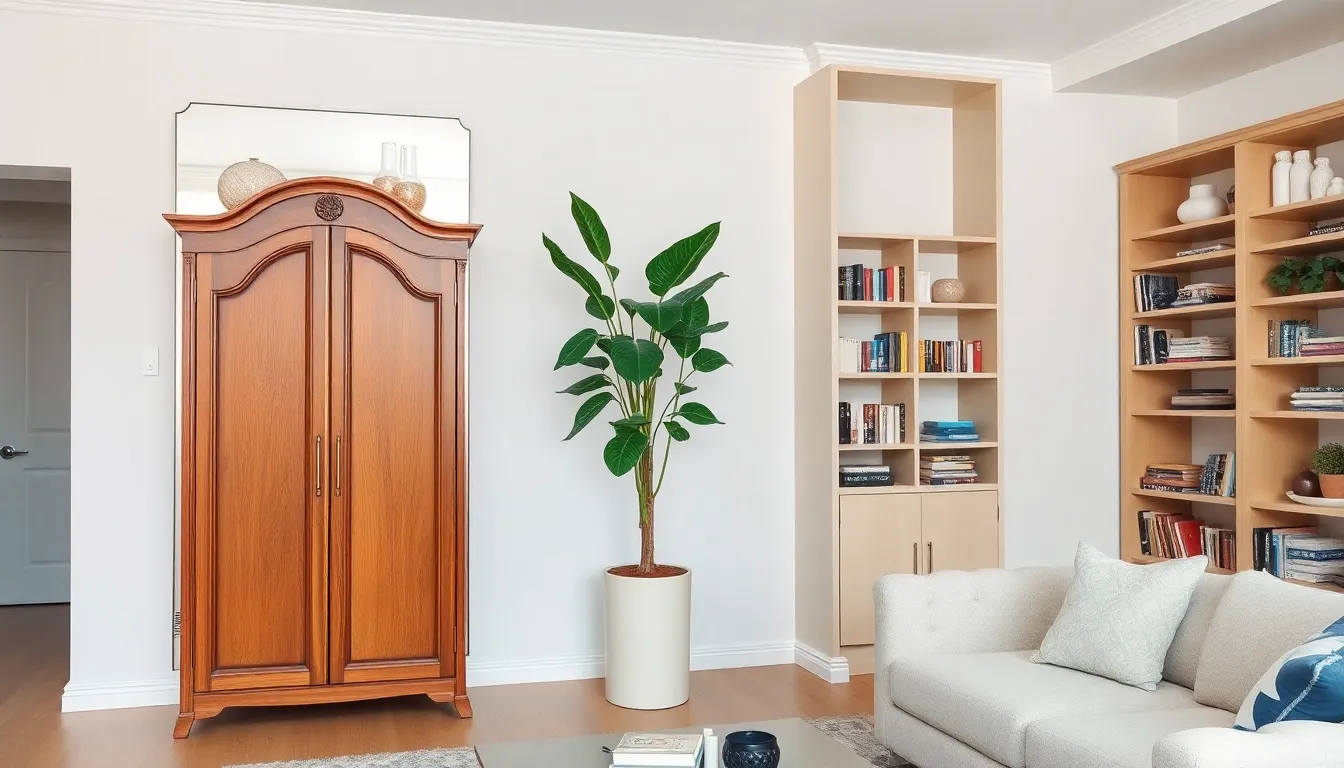
Positioning tall furniture pieces creates the most natural approach to managing floor-to-ceiling mirrors in your living room. Strategic placement allows us to maintain the mirror’s benefits while reducing overwhelming reflections through thoughtful furniture arrangement.
Place Armoires or Wardrobes as Room Dividers
Armoires and wardrobes offer dual functionality when positioned in front of mirrored walls. These substantial pieces create visual barriers while serving as practical storage answers for linens, electronics, or seasonal items. We recommend selecting pieces that complement your existing decor style, whether you prefer traditional wooden armoires with ornate details or sleek modern wardrobes with clean lines.
Positioning these pieces at an angle can create interesting sight lines while partially concealing the mirror’s expanse. The height of most armoires naturally aligns with standard ceiling heights, providing complete coverage for the lower portion of your mirror installation. Consider pieces with doors that open away from the mirror to maintain easy access while maximizing the blocking effect.
Use Tall Plant Stands with Dramatic Greenery
Plant stands create organic coverage that brings life and color to your mirrored living space. We suggest using tall plant stands paired with dramatic foliage like fiddle leaf figs, bird of paradise plants, or large monstera deliciosa varieties. These natural elements soften the mirror’s reflective intensity while adding texture and visual interest.
Grouping multiple plant stands at varying heights creates a layered effect that effectively obscures portions of the mirror without completely blocking natural light. The greenery’s organic shapes provide a beautiful contrast against the mirror’s geometric lines. Consider stands made from materials like bamboo, rattan, or wrought iron to coordinate with your room’s existing aesthetic elements.
Arrange Bookcases to Block Mirror Views
Bookcases provide excellent coverage while adding storage and display opportunities to your living room. We recommend floor-to-ceiling units that can be positioned to block exact sections of the mirror while maintaining access to other areas. Open-back bookcases work particularly well since they allow some light to filter through while reducing the mirror’s visual impact.
Arranging bookcases in an L-shape or creating a library corner effectively manages large mirror installations. The vertical lines of book spines create visual rhythm that draws attention away from reflective surfaces. Consider mixing books with decorative objects, plants, and artwork on your shelves to create an captivating focal point that naturally commands attention away from the mirror’s overwhelming presence.
Create Vertical Garden Walls for Natural Beauty

Vertical garden walls offer one of the most stunning ways to transform floor to ceiling mirrors into living artwork. We can create a breathtaking natural focal point that completely changes the room’s atmosphere while maintaining the structural benefits of the existing mirror installation.
Install Living Plant Walls for Fresh Appeal
Living plant walls transform mirror surfaces into vibrant ecosystems that breathe life into our living spaces. We recommend installing modular panel systems or pocket planters that accommodate real flowers, herbs, and succulents for maximum visual impact. These systems create natural texture and color variation while the trailing vines and cascading foliage soften harsh reflective surfaces.
Plants with different growth patterns work together to create depth and visual interest across the mirror wall. We suggest selecting indoor varieties that thrive in your lighting conditions, such as pothos, philodendrons, and spider plants for areas with moderate light. Vertical gardens also improve indoor air quality naturally, making our living rooms healthier while adding organic beauty.
Installation requires proper drainage systems and waterproof backing to protect the mirror underneath. We recommend consulting with plant specialists to ensure proper plant selection and care requirements for long term success.
Use Artificial Greenery for Low Maintenance
Artificial greenery panels provide the same lush visual appeal as living walls without ongoing maintenance requirements. We can install high quality synthetic vines and foliage that look remarkably realistic while requiring no watering, pruning, or special lighting considerations. This option works perfectly for busy households or spaces with limited natural light.
Modern artificial plants offer incredible realism with varied textures, colors, and growth patterns that mimic natural vegetation. We suggest choosing panels with different plant varieties to create authentic looking diversity across the mirror surface. UV resistant materials ensure colors won’t fade over time, maintaining their fresh appearance indefinitely.
These low maintenance answers allow us to achieve the garden wall aesthetic without worrying about plant care, travel schedules, or changing seasons. Installation involves simple mounting systems that can be easily updated or rearranged as our design preferences evolve.
Combine Plants with Wooden Trellis Systems
Wooden trellis systems create the perfect framework for integrating climbing plants over mirror surfaces. We can install attractive lattice patterns that add architectural interest while supporting both real and artificial climbing vegetation. This combination brings natural wood tones into the space while breaking up large reflective surfaces with organic patterns.
Cedar and teak trellis options provide durability and natural beauty that complements various interior design styles. We recommend positioning the trellis 2 to 3 inches away from the mirror surface to allow proper air circulation and prevent moisture issues. Climbing plants like ivy, jasmine, or artificial alternatives can weave through the wooden framework for a charming garden effect.
These hybrid systems offer flexibility in plant choices and maintenance levels while adding dimensional depth to flat mirror walls. We can customize trellis spacing and wood finishes to match existing furniture and create cohesive design elements throughout our living room.
Apply Temporary Wall Coverings for Easy Changes
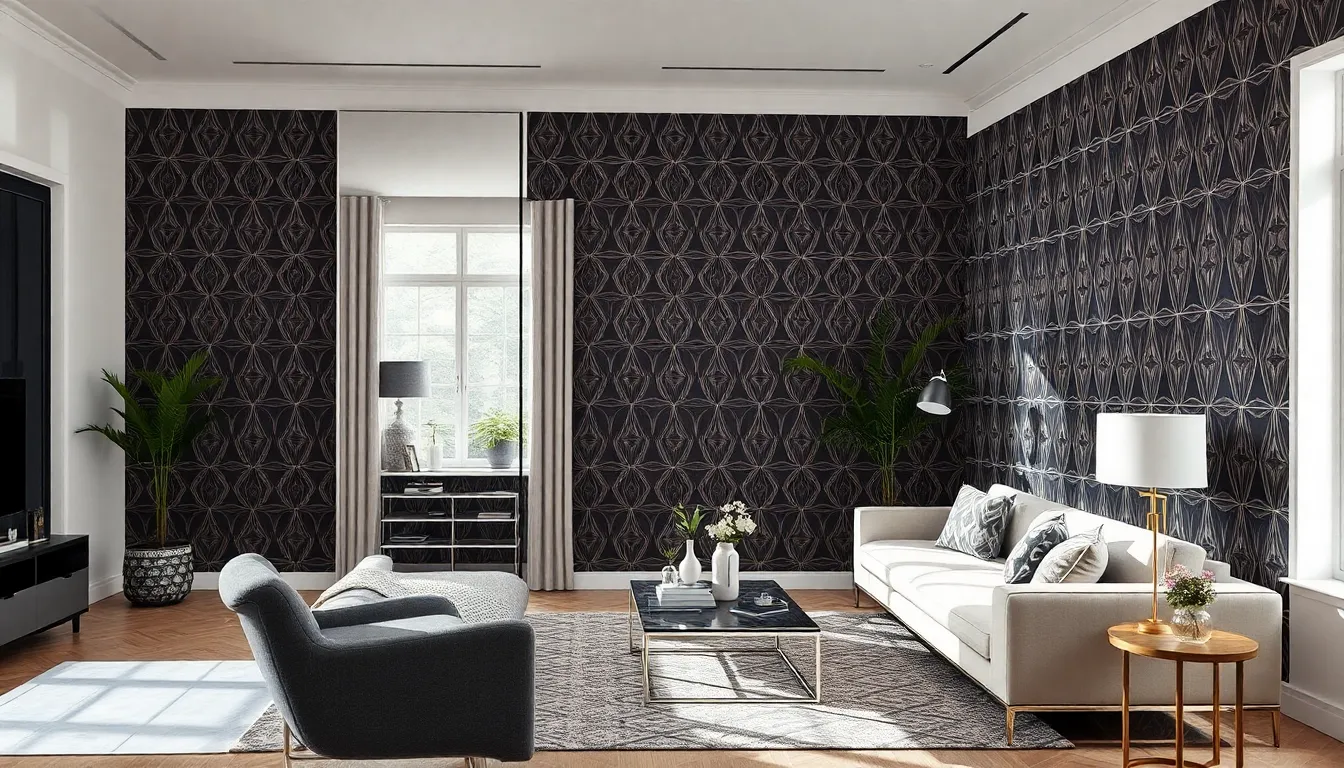
Temporary wall coverings offer the perfect solution for transforming floor-to-ceiling mirrors without permanent modifications or damage to the surface. We can easily update our living room aesthetic while maintaining flexibility for future design changes.
Use Removable Wallpaper for Rental-Friendly Options
Removable wallpaper provides an ideal choice for renters who want stylish transformations without risking security deposits. We can apply these specially designed wallpapers directly over mirror surfaces and remove them later without leaving any residue or damage. Patterns range from subtle textures to bold geometric designs, allowing us to customize our space according to current interior design trends.
Selection matters when choosing removable wallpaper for mirror coverage. We should look for high-quality adhesive backing that ensures smooth application while maintaining easy removal capabilities. Popular finishes include matte, textured, and even metallic options that complement various living room styles from modern minimalist to traditional elegance.
Installation becomes straightforward with proper preparation and technique. We need to clean the mirror surface thoroughly before application to ensure optimal adhesion. Starting from one corner and working systematically across the surface prevents air bubbles and ensures professional-looking results.
Install Peel-and-Stick Wood Panels
Peel-and-stick wood panels create an elegant, textured appearance that adds warmth and sophistication to our living space. We can choose from real wood veneers or high-quality faux wood options that provide the same visual impact at a more affordable price point. These panels require no professional tools or damaging adhesives, making installation accessible for most homeowners.
Customization options include various wood tones and grain patterns to match our existing decor. We can select from popular choices like oak, walnut, or reclaimed wood styles that complement furniture and flooring throughout the room. Panel sizes vary, allowing us to create seamless coverage or interesting geometric patterns depending on our design preferences.
Trimming capabilities make these panels versatile for any mirror configuration. We can easily cut panels to fit around outlets, switches, or architectural features using standard household tools. Precise measurements ensure professional results while maintaining the flexibility to adjust coverage areas as needed.
Apply Fabric Wall Coverings with Starch Method
Fabric wall coverings using the starch method offer a completely reversible solution that’s perfect for renters and frequent decorators. We mix liquid starch with water to create a paste that adheres fabric to mirror surfaces without glue, staples, or any permanent fasteners. This technique allows us to achieve custom looks while ensuring easy removal that leaves no marks or damage.
Material selection opens endless design possibilities for our mirror transformation. We can choose from cotton, linen, or polyester fabrics in patterns ranging from subtle textures to vibrant prints. Lightweight to medium-weight fabrics work best with this method, providing smooth coverage without sagging or wrinkling over time.
Application process requires minimal supplies and basic preparation steps. We need liquid starch, water, a mixing container, and a smoothing tool like a plastic scraper or credit card. The fabric washes off easily with warm water, making this method ideal for seasonal updates or experimenting with different design concepts throughout the year.
Conclusion
We’ve explored many creative approaches to transform those overwhelming floor-to-ceiling mirrors in your living room. From elegant curtain answers and artistic displays to living plant walls and temporary coverings each method offers unique benefits for different lifestyles and budgets.
The beauty of these techniques lies in their flexibility. Whether you’re a renter seeking removable options or a homeowner ready for permanent changes you’ll find answers that work for your situation. Many of these approaches can even be combined for maximum impact.
Remember that transforming mirrored walls doesn’t require extensive renovations or huge expenses. With the right approach you can create a balanced inviting space that reflects your personal style while maintaining the functional benefits these mirrors originally provided.
Frequently Asked Questions
Can I cover floor-to-ceiling mirrors without damaging them?
Yes, there are many non-permanent solutions to cover mirrors without damage. Options include removable wallpaper, decorative window films, curtains with ceiling-mounted tracks, and peel-and-stick panels. These methods allow you to transform the space while preserving the original mirrors underneath, making them perfect for renters or those who want flexibility in their design choices.
What’s the most cost-effective way to hide mirrored walls?
Curtains or drapes are typically the most budget-friendly solution for covering floor-to-ceiling mirrors. They’re easy to install using ceiling-mounted tracks, can be opened or closed as needed, and come in countless styles to match your decor. Alternatively, removable wallpaper and decorative window films offer affordable permanent coverage options.
How do I measure for curtains to cover floor-to-ceiling mirrors?
Measure the exact height from ceiling to floor and the width of the mirror wall. Add 4-6 inches to the width for proper coverage and fullness. For ceiling-mounted tracks, ensure you account for the track’s projection from the wall. Use weighted hems to achieve a polished, professional appearance that hangs straight against the mirror surface.
Can I use artwork to cover parts of a mirrored wall?
Absolutely! Large canvas prints, tapestries, or gallery walls can effectively break up overwhelming mirror surfaces. Ensure proper mounting with appropriate hardware for the wall type. Oversized pieces create bold focal points, while multiple smaller artworks can create visual interest and distract from the mirror’s reflective properties.
Are decorative window films easy to apply to mirrors?
Yes, decorative window films are designed for easy DIY application. Clean the mirror surface thoroughly, then apply the film using a squeegee to remove air bubbles. Options include frosted patterns, colored films, and etched glass designs. Most films are removable and repositionable, making them ideal for updating your design as preferences change.
What plants work best for vertical garden walls over mirrors?
For living walls, choose low-light plants like pothos, philodendrons, and ferns that thrive indoors. Succulents work well in brighter areas. Artificial greenery panels offer a maintenance-free alternative that looks realistic. Consider the room’s lighting conditions and your maintenance preferences when selecting between live and artificial options.
How do I install floating shelves over mirrored walls?
Use appropriate anchors designed for your wall type behind the mirror. Locate wall studs when possible for maximum support. Install shelves at strategic heights to create visual layers while leaving some mirror visible. Consider adding LED strip lighting under shelves for ambient lighting and to highlight decorative items.
Can I paint over floor-to-ceiling mirrors?
While possible, painting directly on mirrors isn’t recommended as it may damage the reflective surface. Instead, consider removable solutions like decorative films, temporary wall coverings, or installing panels in front of the mirrors. These alternatives provide the painted look you want while preserving the mirrors underneath for future use.

